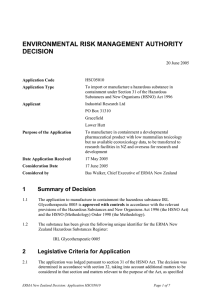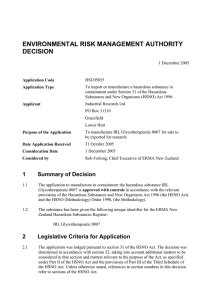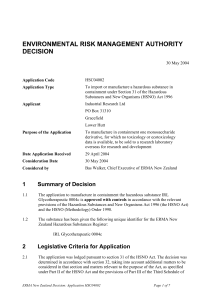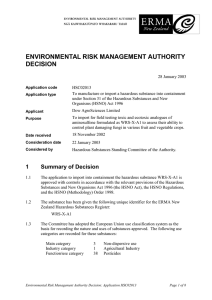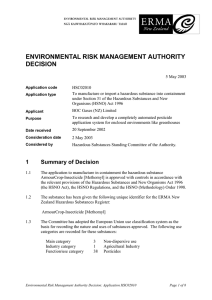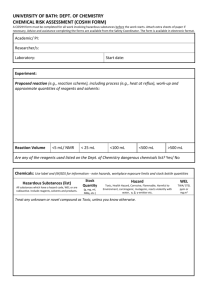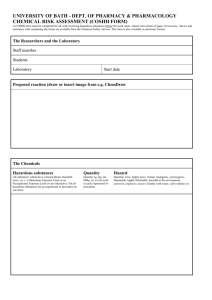ENVIRONMENTAL RISK MANAGEMENT AUTHORITY DECISION
advertisement
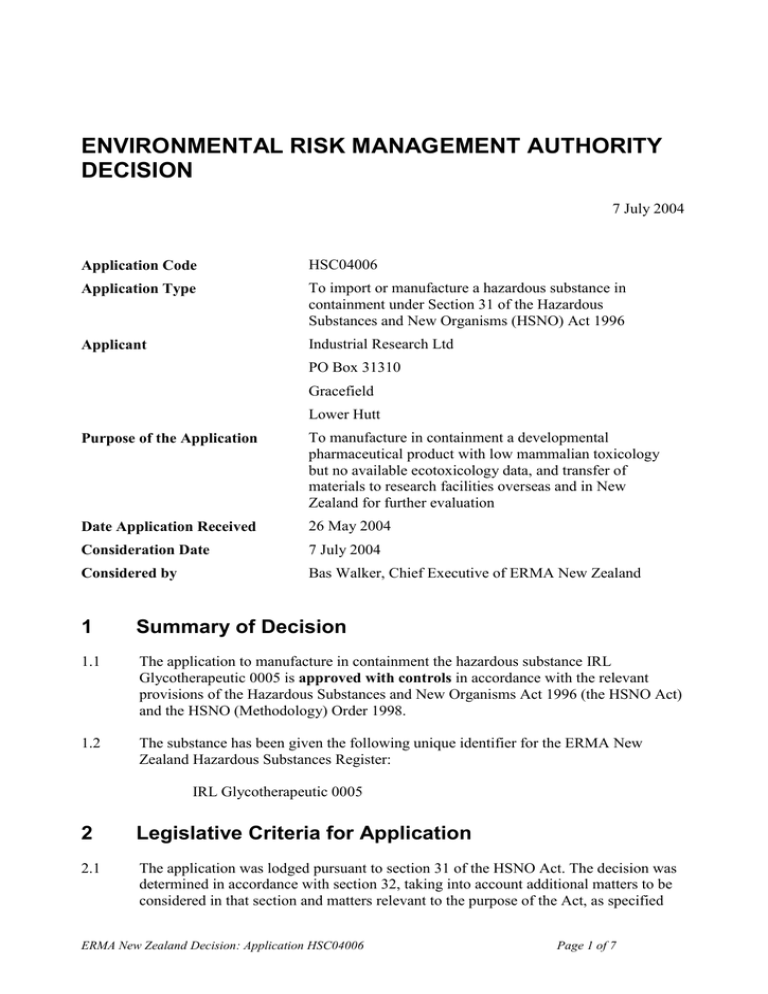
ENVIRONMENTAL RISK MANAGEMENT AUTHORITY DECISION 7 July 2004 Application Code HSC04006 Application Type To import or manufacture a hazardous substance in containment under Section 31 of the Hazardous Substances and New Organisms (HSNO) Act 1996 Applicant Industrial Research Ltd PO Box 31310 Gracefield Lower Hutt Purpose of the Application To manufacture in containment a developmental pharmaceutical product with low mammalian toxicology but no available ecotoxicology data, and transfer of materials to research facilities overseas and in New Zealand for further evaluation Date Application Received 26 May 2004 Consideration Date 7 July 2004 Considered by Bas Walker, Chief Executive of ERMA New Zealand 1 Summary of Decision 1.1 The application to manufacture in containment the hazardous substance IRL Glycotherapeutic 0005 is approved with controls in accordance with the relevant provisions of the Hazardous Substances and New Organisms Act 1996 (the HSNO Act) and the HSNO (Methodology) Order 1998. 1.2 The substance has been given the following unique identifier for the ERMA New Zealand Hazardous Substances Register: IRL Glycotherapeutic 0005 2 Legislative Criteria for Application 2.1 The application was lodged pursuant to section 31 of the HSNO Act. The decision was determined in accordance with section 32, taking into account additional matters to be considered in that section and matters relevant to the purpose of the Act, as specified ERMA New Zealand Decision: Application HSC04006 Page 1 of 7 under Part II of the HSNO Act and the provisions of Part III of the Third Schedule of the HSNO Act. Unless otherwise stated, references to section numbers in this decision refer to sections of the HSNO Act. 2.2 Consideration of the application followed the relevant provisions of the Hazardous Substances and New Organisms (Methodology) Order 1998 (the Methodology). Unless otherwise stated, references to clauses in this decision refer to clauses of the Methodology. 3 Application Process 3.1 The application was formally received on 26 May 2004 and assessed as having sufficient information on 27 May 2004. 3.2 Project Team: Beth Dye Applications Advisor (Hazardous Substances) Tania van Maanen Science Advisor (Hazardous Substances) Report review and sign-out by: Peter Dawson Principal Scientist (Hazardous Substances) 3.3 The applicant supplied the following documents: The application, including confidential appendices containing commercially sensitive information. 3.4 The following Government departments were advised of the receipt of the application (in accordance with clause 2(2)(e)) and given the opportunity to comment: The Ministry of Health The Department of Labour (Occupational Safety and Health) The New Zealand Food Safety Authority (Agricultural Compounds and Veterinary Medicines Group (ACVM Group)). 3.5 No responses were received. 3.6 The applicant was provided with a copy of the proposed controls for IRL Glycotherapeutic 0005 and given the opportunity to comment on them. The applicant raised no issues with the proposed controls. 4 Consideration Sequence of the Consideration 4.1 This application was considered by the Chief Executive of ERMA New Zealand under delegated powers from the Authority (section 19(2)(e) of the HSNO Act). ERMA New Zealand Decision: Application HSC04006 Page 2 of 7 4.2 In accordance with section 32 of the Act, the approach adopted when considering this application was to confirm whether the application was for one of the purposes specified in section 30, to identify and assess the risks and to determine whether the substance could be adequately contained by controls to provide for each of the matters specified in Part III of the Third Schedule of the Act. Purpose of the Application 4.3 The purpose of the application is to manufacture in containment a developmental pharmaceutical product with low mammalian toxicology but no available ecotoxicology data, and includes the transfer of the substance to research facilities overseas and in New Zealand for further evaluation. 4.4 As the purpose amounts to “research and development on any hazardous substance”, I consider that the application qualifies for consideration under section 30(ba) of the Act. Description and Use of the Substance 4.5 IRL Glycotherapeutic 0005 is comprised of an organic active ingredient in a complex with beta-cyclodextrin as a carrier, for use in pharmaceutical research. It is being developed as a treatment for Freidreich’s ataxia and Huntingdon’s Disease. Hazardous Properties 4.6 I note that a containment application only requires sufficient understanding of the hazardous properties to ensure that any risks can be managed by the containment controls. 4.7 The applicant states that IRL Glycotherapeutic 0005 is a complex formed between the active chemical and the carrier. The toxicity and ecotoxicity of the substance are largely unknown, but the applicant considers that by comparison with similar substances, any toxicity or ecotoxicity is expected to be low. It is not expected to have any explosive, flammable or oxidising hazardous properties. 4.8 The active chemical is a new substance and there is no published information on its toxicology or ecotoxicity. The portion of the molecule responsible for its anti-oxidant properties is nevertheless closely related to the nutritional supplement ingredient idebenone, which is consumed widely by humans in the USA. 4.9 The carrier, beta-cyclodextrin, is a low toxicity, naturally occurring compound used as food additive. 4.10 I have reviewed the applicant’s hazard information. This is insufficient to fully describe the hazards of the substance but provides a workable basis for setting the containment controls to ensure that any risks can be adequately managed. Life Cycle 4.11 IRL Glycotherapeutic 0005 will be synthesised at Industrial Research Limited, Gracefield Research Centre, Lower Hutt, within purpose-built facilities. Once ERMA New Zealand Decision: Application HSC04006 Page 3 of 7 synthesised, up to 2.5 kilograms will be shipped overseas for toxicology studies in animals. A second batch of up to 15 kilograms will be shipped to Auckland for formulation into tablets by Douglas Pharmaceuticals Ltd at their cGMP rated facility which accredited by Medsafe. Once appropriate approvals have been obtained from each of the relevant regulatory authorities (in New Zealand, Ministry of Health Standing Committee on Therapeutic Trials), it will be shipped from there to Christchurch, Australia and the USA for use in clinical trials. Identification and Evaluation of the Significant Risks of the Substance in Containment 4.12 In accordance with sections 5, 6, and 8 and clauses 9 and 11, I considered the potential risks of escape from containment under the headings of environmental, human health and welfare and Māori issues and concerns. 4.13 In the application, the applicant identified and assessed potential risks, and detailed proposals for, and impacts of risk management. I have reviewed the applicant’s assessment of risks and agree that it is suitable for the consideration below. Risks to the Environment 4.14 No ecotoxicological data are available on the substance, but the applicant considers that by comparison with similar substances, any ecotoxicity is expected to be low. 4.15 On the basis of the lifecycle of the substance outlined in paragraph 4.11, adverse effects could arise from: An accident during manufacture or transportation, resulting in release of the substance. 4.16 I note that a maximum of 17.5 kilograms of the substance will be manufactured. I note that the synthesis facilities have primary, secondary and tertiary containment, and that export of the substance will be in a container within a container, with the secondary container sufficient to control any release should the primary container be damaged and leak. 4.17 I consider that, taking into account the likely properties of the substance, the quantity involved, the containment controls in Appendix 1 and controls in place under other legislation, there are no significant risks to the environment. Risks to Human Health and Welfare 4.18 Limited toxicological data are available on the substance, but the applicant considers that by comparison with similar substances, any toxicity is expected to be low. 4.19 On the basis of the lifecycle of the substance outlined in paragraph 4.11, adverse effects on human health and welfare could arise from: An accident, resulting in exposure during manufacture or transportation. 4.20 I note that a maximum of 17.5 kilograms of the substance will be manufactured. I note that the synthesis facility has been designed with a focus on operator safety, and that ERMA New Zealand Decision: Application HSC04006 Page 4 of 7 export of the substance will be in a container within a container, with the secondary container sufficient to control any release should the primary container be damaged and leak. 4.21 I consider that, taking into account the likely properties of the substance, the quantity involved, the containment controls in Appendix 1 and controls in place under other legislation, there are no significant risks to human health and welfare. Māori issues and concerns 4.22 I have considered the potential Māori cultural effects of this application in accordance with sections 6(d) and 8 of the HSNO Act 1996, and the assessment framework contained in the ERMA New Zealand User Guide “Working with Māori under the HSNO Act 1996”. 4.23 I consider that the substance is unlikely to have an impact on the relationship of Māori and their culture and traditions with their ancestral lands, water, sites, waahi tapu, valued flora and fauna and other taonga. This is on the condition that the substance is used in accordance with the controls in Appendix 1, and in accordance with any other relevant controls applied under other legislation. 5 Containment and Controls 5.1 I have evaluated the adequacy of the containment arrangements proposed by the applicant and the controls listed in Appendix 1, and note that these cover the matters set out in Part III of the Third Schedule of the Act, being: To limit the likelihood of escape of any contained hazardous substances or contamination by hazardous substances To exclude organisms from a facility To exclude unauthorized people from the facility To prevent unintended release of the substances by experimenters working with the substances To control the effects of any accidental release of the substances Inspection and monitoring requirements. 5.2 I am satisfied that with adherence to the controls listed in Appendix 1 and those controls in place under other legislation, the substance can be adequately contained. ERMA New Zealand Decision: Application HSC04006 Page 5 of 7 6 Decision 6.1 I have considered this application under section 31 to manufacture in containment a hazardous substance, and pursuant to section 32, I am satisfied that this application is for the purpose specified in section 30(ba). 6.2 Having considered the risks associated with the lifecycle of IRL Glycotherapeutic 0005, I am satisfied that the controls imposed, including those in place under other legislation, will result in the substance being adequately contained. 6.3 In accordance with clause 36(2)(b) of the Methodology I record that, in reaching this conclusion, I have applied the criteria specified in section 32 of the Act. 6.4 I have also applied the following criteria in the Methodology: clause 9 – equivalent of sections 5, 6 and 8; clause 11 – characteristics of substances; clause 21 – the decision accords with the requirements of the Act and regulations; clause 22 – the evaluation of risks – relevant considerations; clause 24 – the use of recognised risk identification, assessment, evaluation and management techniques. 6.5 The application to manufacture in containment the hazardous substance IRL Glycotherapeutic 0005 is thus approved pursuant to section 32 of the Act, with controls as set out in Appendix 1. Bas Walker Date 7 July 2004 Chief Executive of ERMA New Zealand ERMA New Zealand Approval Code: IRL Glycotherapeutic 0005: HSC000096 ERMA New Zealand Decision: Application HSC04006 Page 6 of 7 Appendix 1: List of controls that apply to the hazardous substance IRL Glycotherapeutic 0005 1. The facilities where the substance will be synthesised shall comply with the Hazardous Substances (Exempt Laboratories) Regulations 2001. Compliance with these regulations will cover the matters to be addressed by the containment controls for hazardous substances contained in Schedule 3, Part III, of the HSNO Act. 2. The substance shall be shipped only to the facilities which have been identified in the application. 3. A maximum of 2.5 kilograms of the substance shall be manufactured for use in toxicology trials, and a maximum of 15 kilograms of the substance shall be manufactured for use in clinical trials. 4. Synthesis shall take place within the facilities at Industrial Research Limited (IRL) as identified in the application. 5. All personnel carrying out the synthesis and packaging of the substance shall wear appropriate personal protective equipment. 6. Handling of the substance shall be in accordance with good laboratory practice. Any spillage of the substance shall be cleaned up with appropriate absorbent material. The used absorbent material shall be securely packaged and retained in the IRL facility until it has been rendered non-hazardous prior to disposal. 7. The substance shall be stored in the IRL facility until it is exported or despatched to the pharmaceutical formulator. Only authorised personnel shall be allowed into the IRL facility, which has access controlled by electronic security systems and is itself located within a controlled access site. 8. The substance shall be packaged for transportation in a container within a container (secondary containment) and that secondary container shall be sufficient to control any release if the primary container should leak. The containers shall comply with the Hazardous Substances (Packaging) Regulations 2001, and shall be labelled in accordance with Regulation 11 of the Hazardous Substances (Exempt Laboratories) Regulations 2001. A Safety Data Sheet shall accompany each shipment. 9. The substance shall be transported in accordance with good practice. This may require compliance with the Land Transport Rule: Dangerous Goods 1999. 10. If for any reason a breach of containment occurs, the Manager: GSF Facility shall notify OSH (HSNO Project Manager) and ERMA New Zealand (Beth Dye) within 24 hours of the breach being detected. It is suggested that if a breach in containment results in contamination of a waterway, the relevant iwi authorities be advised of the contamination and the measures taken in response. 11. The Authority, or its authorised agent or properly authorised enforcement officers, may inspect the facility at any reasonable time. ERMA New Zealand Decision: Application HSC04006 Page 7 of 7
